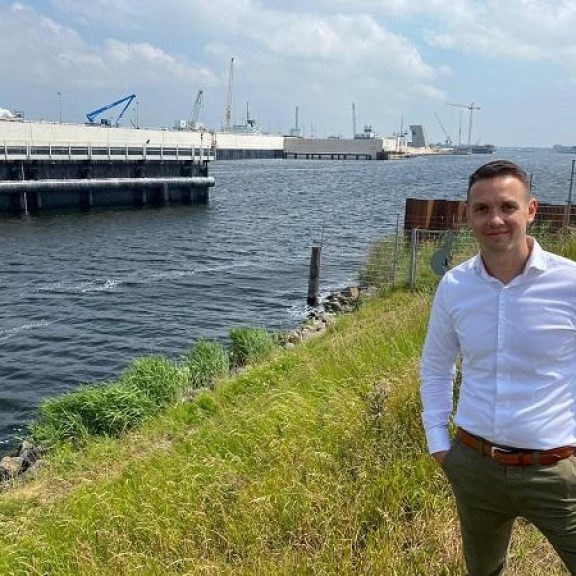
We do anything for minimal inconvenience to traffic
Good cooperation is important, especially with the construction of the new sea lock. Jordy Husslage, Head of Operations at Port of Amsterdam, knows all about it.
Port of Amsterdam's Harbour Master's Division is responsible for a safe, smooth and environmentally sound flow of shipping traffic in the whole of the North Sea Canal area. This area will soon also include the new sea lock. Cooperation between Port of Amsterdam, Rijkswaterstaat and OpenIJ is very important, above all during lock closures. Jordy explained how this works.
"We have consultations at all levels of our respective organisations, including our management, project leaders and site managers. This is especially true in the run-up to a lock closure or an important phase in the construction of the new sea lock. We also have regular meetings during which the entire situation surrounding the construction of the new sea lock is taken into consideration. At the meetings, we discuss nautical matters and look ahead. We nearly always agree on things."
Cooperation in the event of a lock closure
A lock closure is always planned as best as possible and everything is done to limit any inconvenience to shipping traffic. On the day of the lock closure itself, close contact takes place between VTS operators, lock keepers and site managers. Jordy explained, "Lock closures are discussed with Rijkswaterstaat and OpenIJ well in advance. We always check whether a lock closure can be shortened or be divided into several shorter time periods to prevent that a lock is closed to traffic for an entire day. A Shipping Announcement will be published and sent to interested parties at least six weeks in advance. Sometimes we can also limit traffic disruption by combining various activities. The result of this is that there will be only one traffic disruption instead of several ones. The work may also be completed earlier than planned. In that case, we check whether any ships are waiting. If that is not the case, we may be able to carry out additional works to by-pass or prevent nuisance at a later date. We therefore always include a sentence that reads like: ‘The lock closure will take as long as necessary and as short as possible’."
Working together on the upper wheel carriage
Cooperation was essential during installation of the upper wheel carriage. “The installation of the upper wheel carriage into the lock gate chamber is a high-precision process requiring as little water movement as possible. That is why the weather had to be calm without any waves and the Middle Lock had to be closed as well to prevent wash from ships. We followed the same procedure as for other construction activities, but this time was different in that we would get a go-ahead at no more than two days in advance. So it was a very last-minute job in which we had to react fast. Thanks to our good cooperation, however, the work went without a hitch and with as little as possible inconvenience to shipping traffic."
Influence on shipping traffic
“For such a large project as this, the construction of a new sea lock, inconvenience to shipping has been relatively minimal”, Jordy added. Inconveniences that occurred were mainly caused by special operations, such as when the lock gates, assisted by tugs, on their way to Amsterdam had to pass through the lock, or when the upper wheel carriage was installed. At such occasions, the lock complex or part of it will either be closed or other traffic measures will be put in place. Jordy illustrated, "The cofferdams surrounding the outer and inner lock heads will soon be removed. The removal operations will be carried out while shipping traffic continues as normal. Due to the construction of the new sea lock, a restriction at the IJmuiden Middle Lock has been in force for 18 months now, restricting lock passages to ships of not more than 125 metres in length. Thanks to the removal, this restriction will soon be lifted. Inconveniences to shipping due to the construction of the new sea lock are in general quite manageable. Usually, shipping traffic can continue, sometimes with additional traffic control measures, sometimes ships are only required to reduce speed."